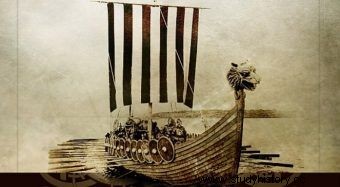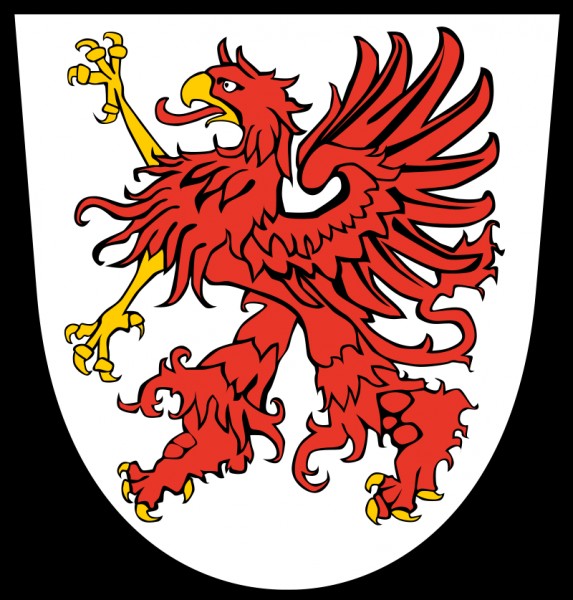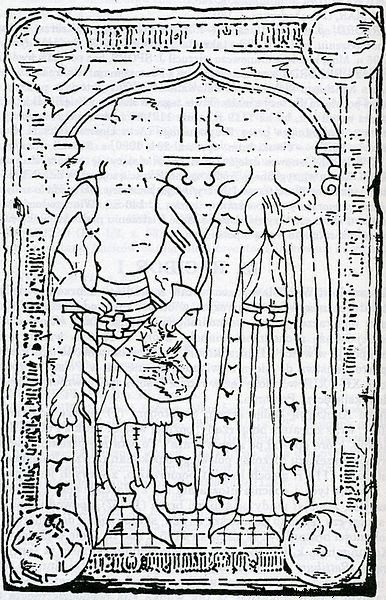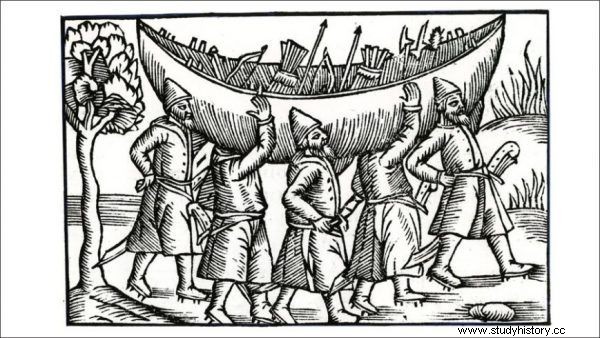It was Sunday in the year of our Lord 1136, when the outline of ships adorned with animal skulls appeared on the horizon, on the Göta älv River, which flows into the Kattegat Sea. The people of the Scandinavian port city of Konungahela knew the worst was imminent:windy! Slavic pirates once again came here to loot and murder without mercy ...
According to the chronicler Snorri Sturulson, the invaders came in the strength of as many as 600 ships. About 30,000 warriors disembarked - thirsty for blood, loot and bandits. They were commanded by Raciobor - the Pomeranian prince of the Griffin dynasty, vassal of the Polish prince Bolesław Krzywousty, formally a Christian, after several years earlier, as a result of the bloody invasion of Bolesław, subjugated Pomerania and forced the adoption of a new faith by force. 
Konungahela (today's Kungälv in Sweden), one of the most important port cities of early medieval Scandinavia, despite being heavily fortified, was doomed to failure. The Slavic invaders first dealt with the merchants who were trying to resist in the port, then they launched an assault on the city. The city went up in smoke, anyone who was not fit for slavery was murdered, then the regular theft began.
"[Slavs] captured all the people - men and women and children - slaughtered many, those who were injured or young (...) and took all their wealth that were in the castle, entered the Church of the Cross and stole all its decorative equipment "- informs the chronicler.

Gryfitów coat of arms
“King Racibor and his victorious armies gave way and returned to Slavia, and a great number of the people who had been taken at Kungahelli then lived long in captivity with the Slavs. The great port of Kungahälla never returned to the same state as before [...] "adds Snorri.
Wiciędze - the Vikings our way
The invasion of the Scandinavian city by the Slavs, although bloody, was nothing exceptional at that time. In the 10th and 11th centuries, Slavic pirates regularly plundered and persecuted with their invasions not only Scandinavia but also German ports - incl. they sacked Hamburg several times. According to Artur Szrejter, author of historical books about Slavic pirates, in the 10th and 11th centuries it was them, and not the Vikings popularized in popular culture, who ruled the Baltic Sea.
The writer emphasizes that although singers from Scandinavia celebrated the great victories of the Vikings in Western Europe in their sagas, there was almost a complete lack of similar reports in the case of, for example, the southern Baltic coast, which was almost across the border. Is this due to the fact that Scandinavian pirates did not venture here because there were no riches here? Nothing like that - the fame of the then Slavic ports, such as Arkona, stretched far, thousands of kilometers away. Jewish and Arab merchants came here, the ports were full of wealth, yet the Scandinavians did not plunder them. Or maybe they avoided meeting the Slavs out of fear? According to Szrejter, it happened more than once that only rumors of impending vicissitudes resulted in the rapid escape of entire Danish fleets in the Baltic Sea.

Racibor and Przybysław
Slavic pirates, known as witches or chrysals, were recruited from groups of young men from the tribes of the southern coast of the Baltic Sea. Piracy was dealt with by the Polabian Slavs - Obodrzyc and Ranowie - living in the area of today's Rügen in Germany, as well as Pomeranians, Wolinians and Szczecin residents. The ships of viceroys moored in the largest ports and commercial settlements of the Slavic part of the Baltic Sea - Arkona, Szczecin or Wineta, probably located on the island of Wolin. Since in those days even a peaceful earnings required proficiency in weapons, merchants from Baltic emporia such as Wineta must also be warriors . This is how the armed layer of sailors was born, often operating in the service of the ruler, but not only.
Slavic pirates certainly exchanged experiences with the Vikings. Both Scandinavians and Slavs were stationed in Jomsborg, which some researchers identify with Wineta and locate them on the Wolin Island. Although they acted similarly, we can also point out some important differences. Slavic pirates sailed on slightly smaller, but more maneuverable boats that could accommodate about 40 warriors . Instead of carved images of dragons, they decorated them with animal skulls - bears, aurochs, wolves, etc.
Slavic god's whip
To this day, vicissitudes have hardly been mentioned by Polish historiography, meanwhile they have appeared many times in the songs of scalds, sagas and Scandinavian chronicles (eg Saxo Grammaticus) or German (eg Adam Bremeński). For a long time, native historians did not believe them, despite the fact that their colleagues from Scandinavia did. Today we know that chain links constituted a very important, and more or less in the 11th - 12th centuries, the dominant force in the Baltic Sea. More than once they were involved in wars with the Vikings, or between Viking clans as allies of one of the parties. They took part, for example, in the naval battle of Svolder in 1000, where the forces of the Danish ruler Sven Forkbeard and the Norwegian king - Olaf Tryggvason clashed. They raided Germany and Denmark on a regular basis. In 983 the Duke of Obodrzycki Mściwój captured, plundered and burned German Hamburg. In the same period (around 992), the victories were won by one of the largest and most important trading cities in Scandinavia - Hedeby, located on the Danish coast.

A print showing the pigs carrying their boat
A year before the conquest of Konungaheli, Prince Racibor invaded Zealand. The Slavs blew up the then capital of Denmark - Roskilde. The result of the invasions on the local coast - from Jutland to Scania - was the almost complete depopulation of these lands. As the chronicler Saxo Grammaticus recalls - “all the villages abandoned by the inhabitants from the east (...) lay without cultivation. Zealand from the east to the south (...) was empty (...), there was nothing left on Funen except a few inhabitants ".
The end of vicissitudes
The end of the viceroy era, just like the Vikings, was Christianization. Until the very end, the Polabian Slavs, almost to the physical destruction of their people, resisted adopting a new religion, which was identified with their greatest enemy - Germany. For the Polabians, Christ was "the German god" . In the second half of the 12th century, when the insolence of the Slavic invasions took its toll on both the Germans and the Danes, both countries united their forces. In 1168 the Danish king Waldemar I conquered Rügen with Arkona. The temple of Świętowit was destroyed, and the inhabitants of the town were baptized by force. Soon after, the remaining tribes of the Baltic Slavs - Obodrzyce and Wieleci were subjected to the Saxon or Danish conquest. After them, Pomeranians fell into the orbit of Danish and German influence. This is how the era of viceroys ended - fearless, Slavic pirates, rulers of the Baltic Sea.
